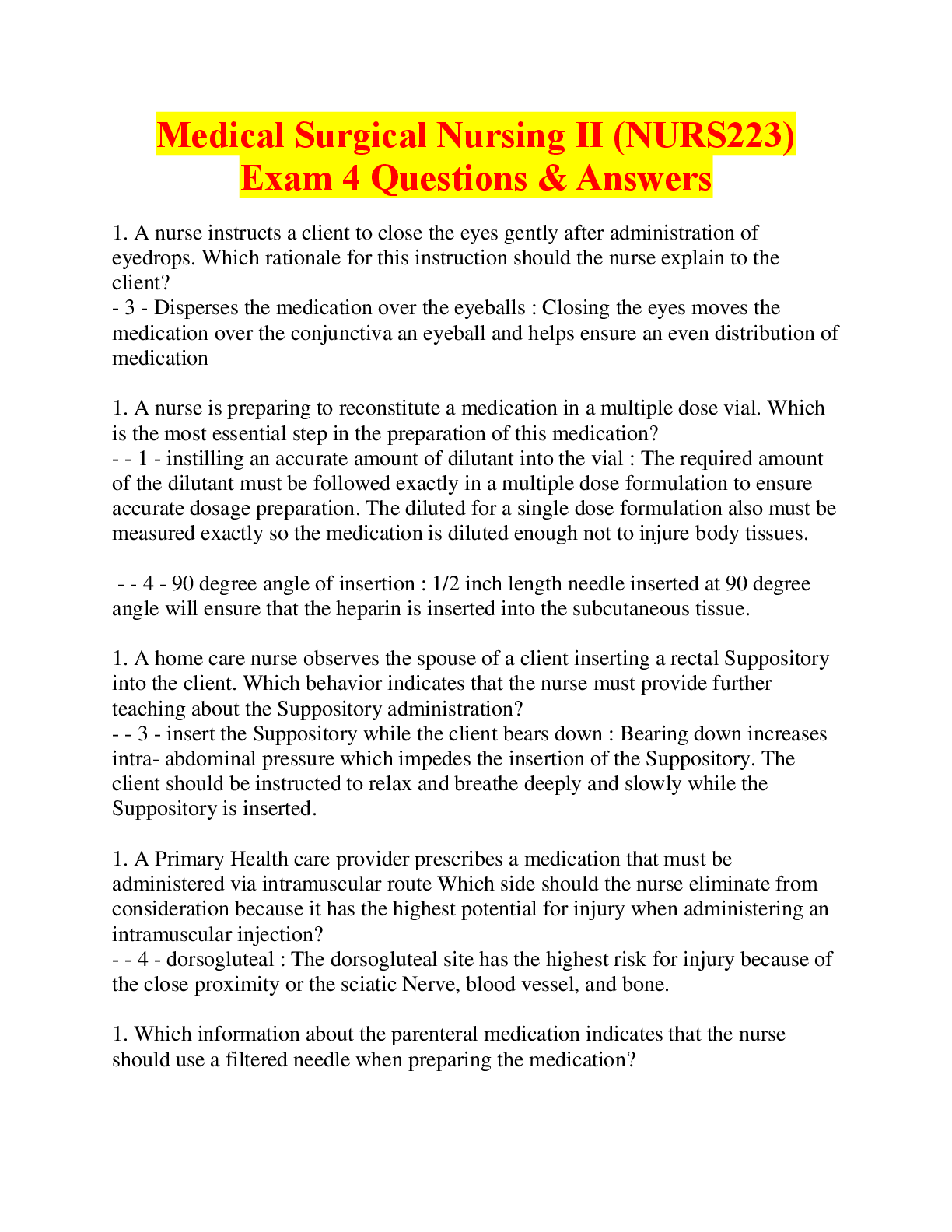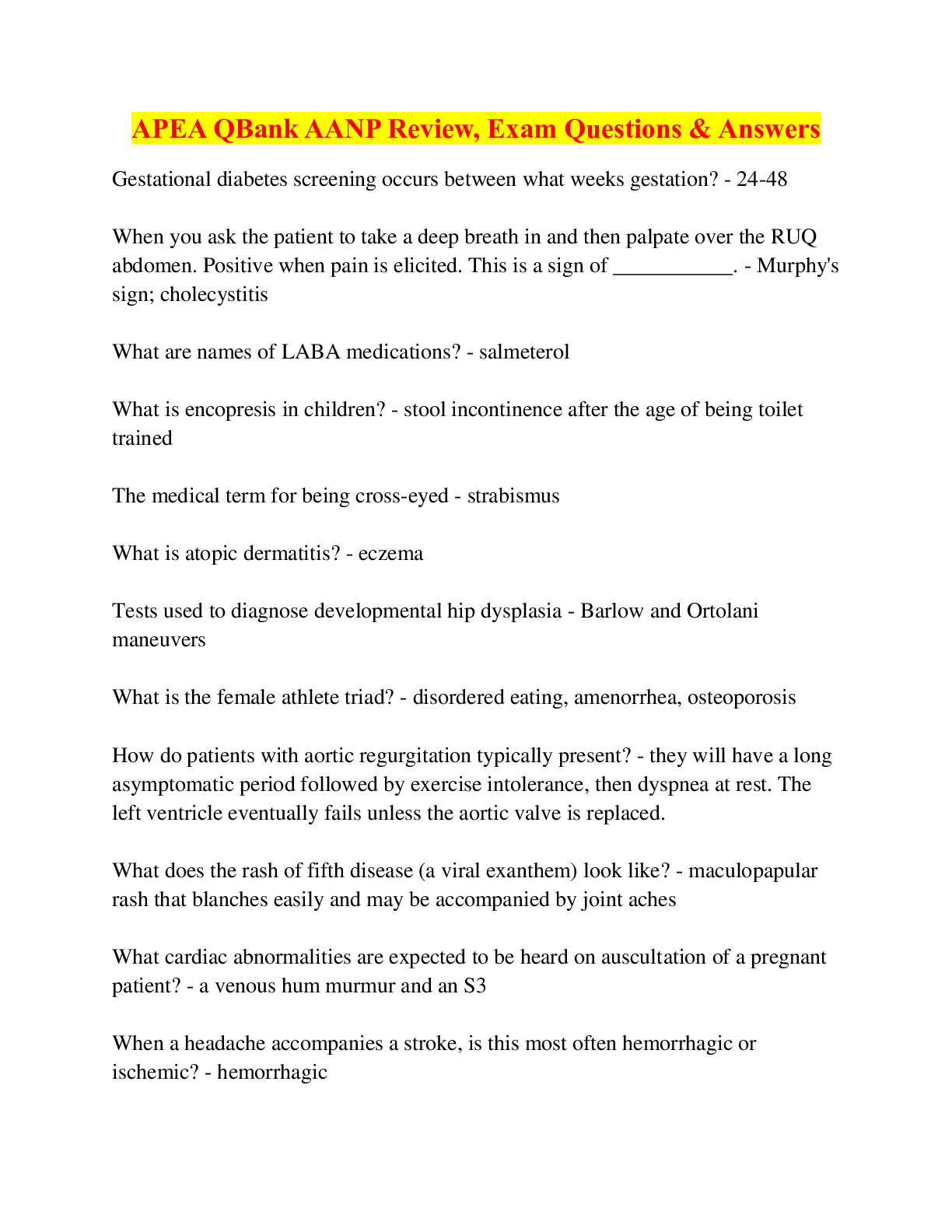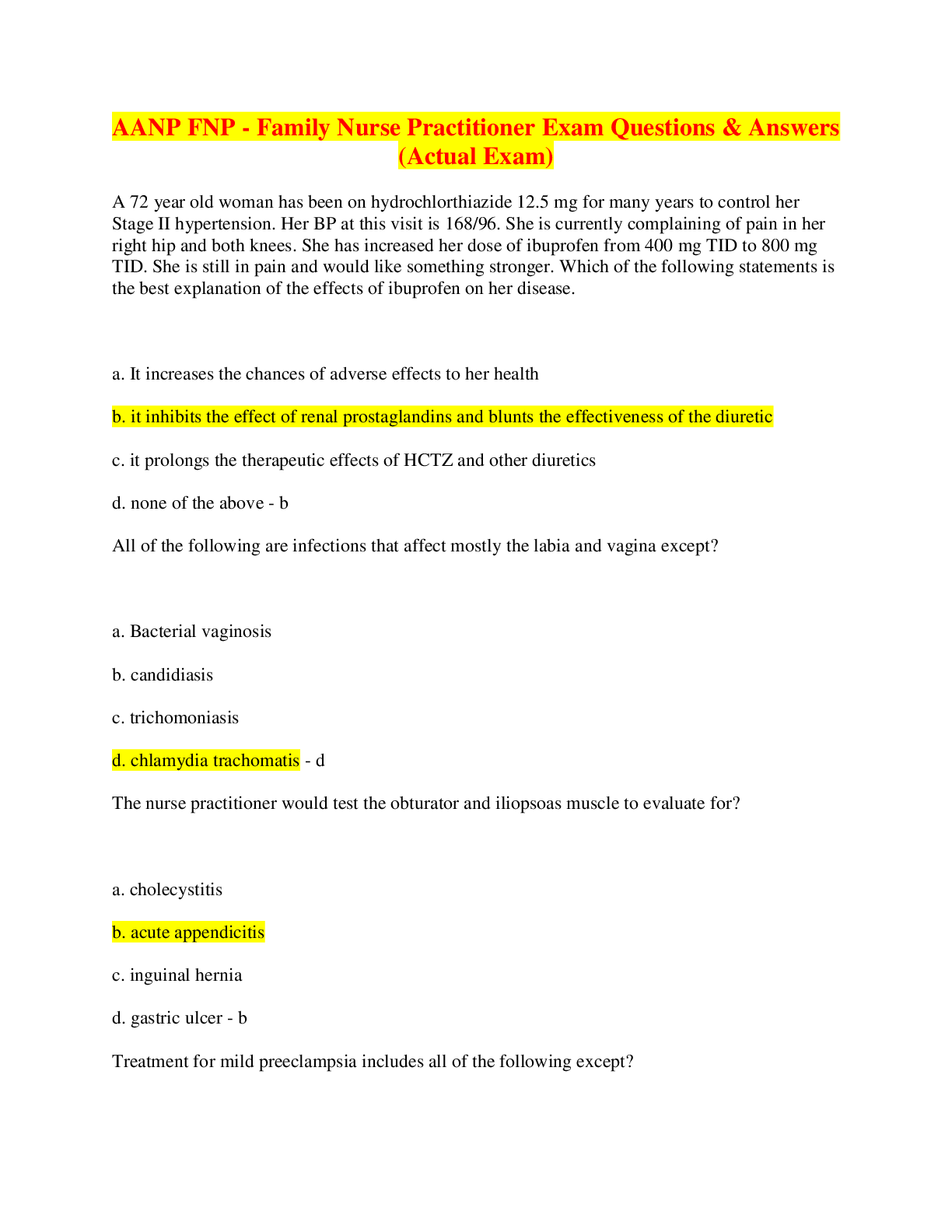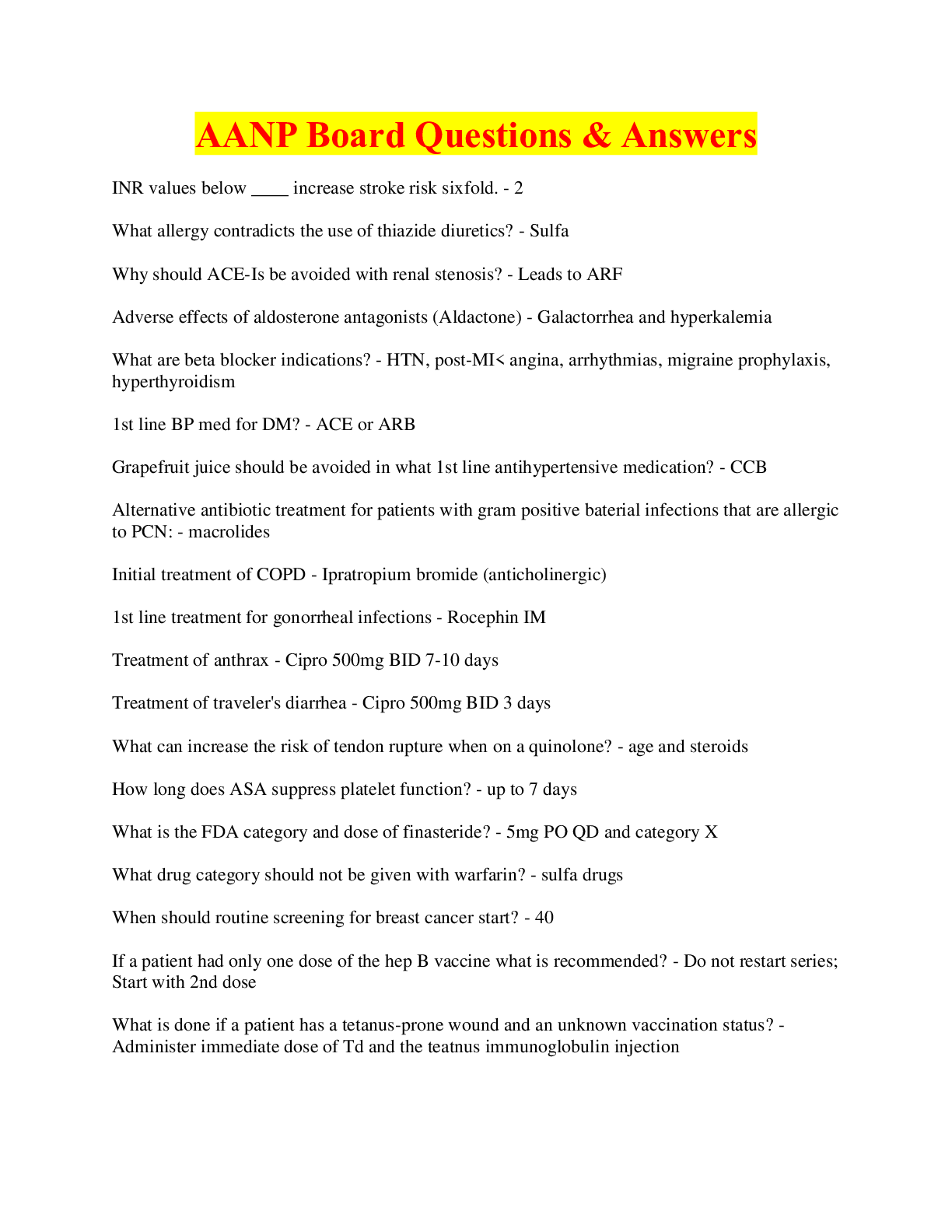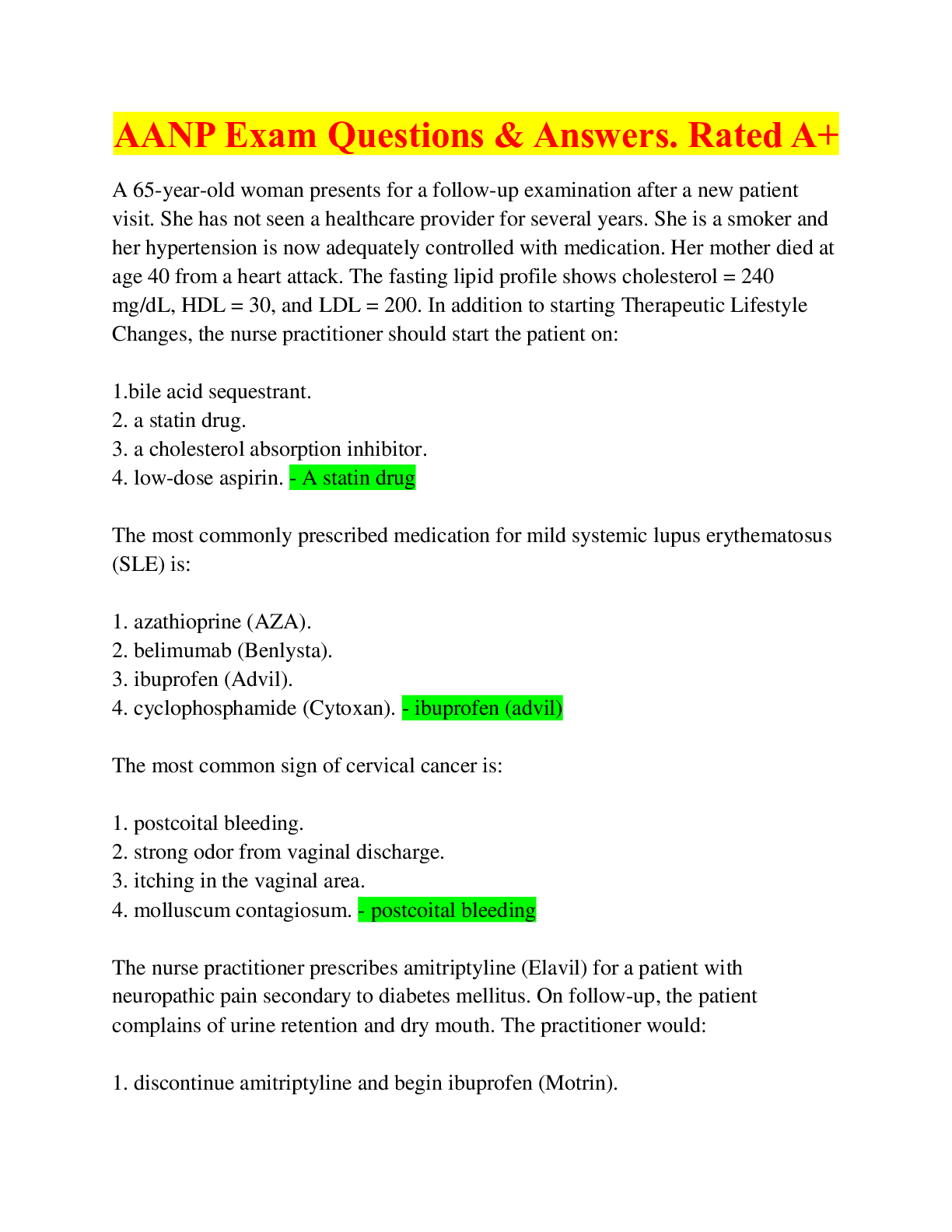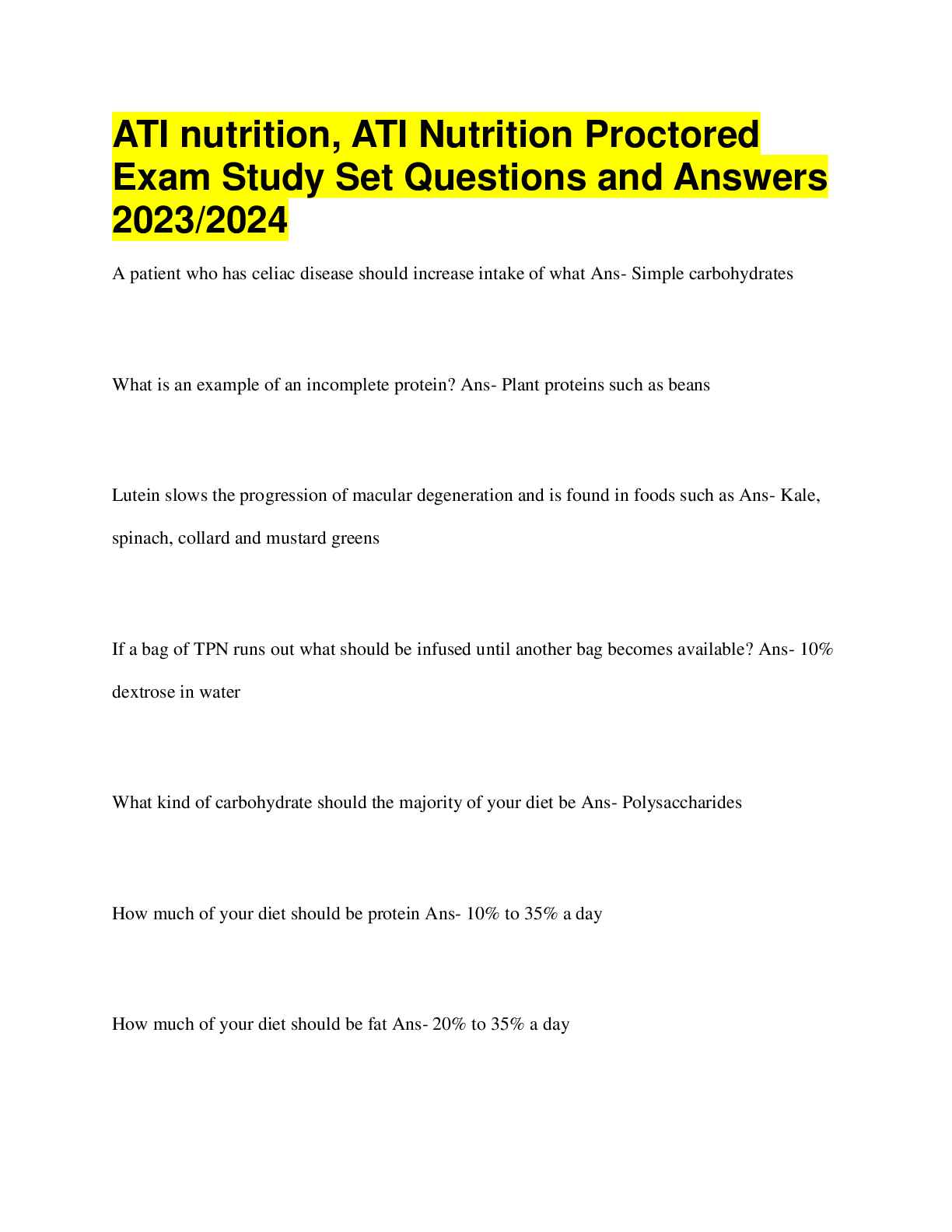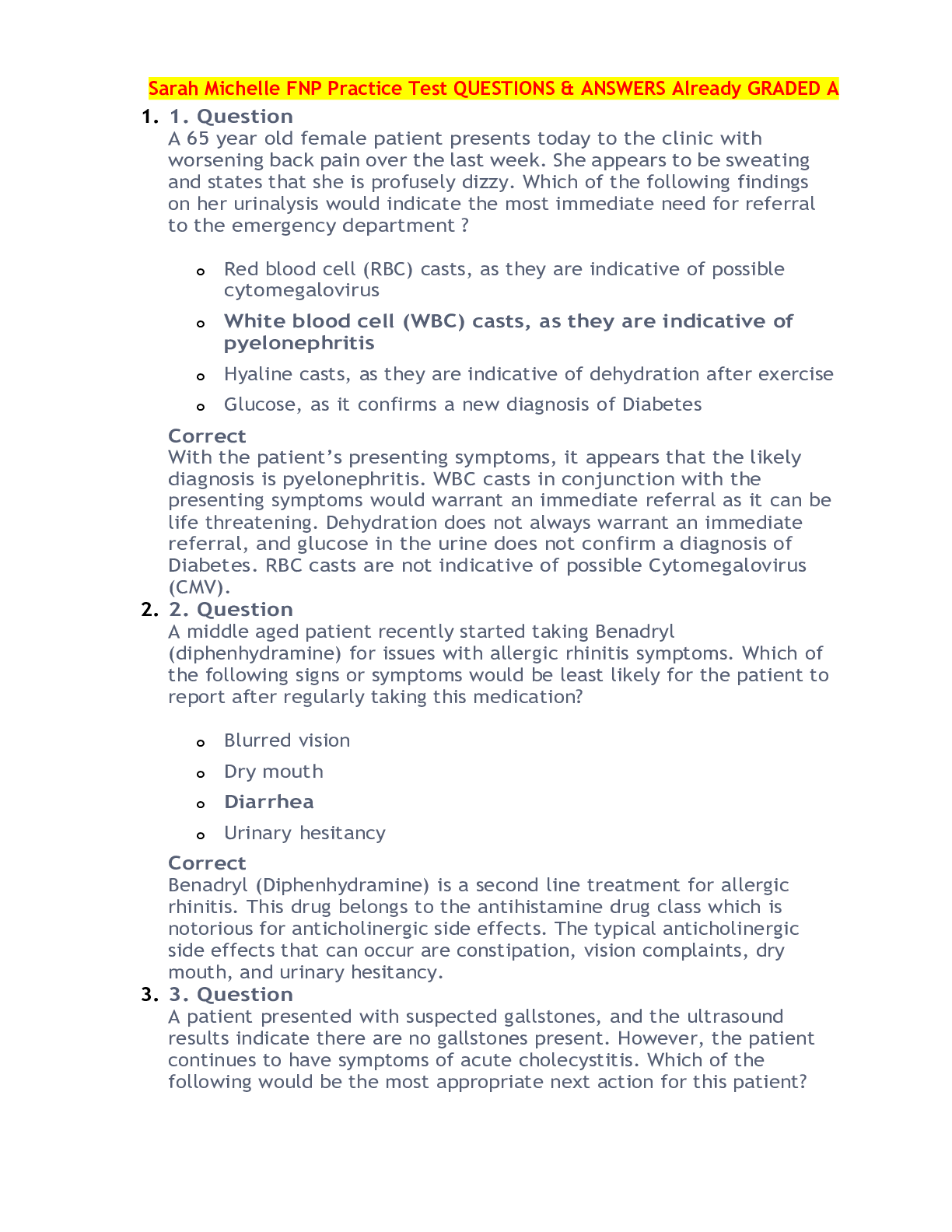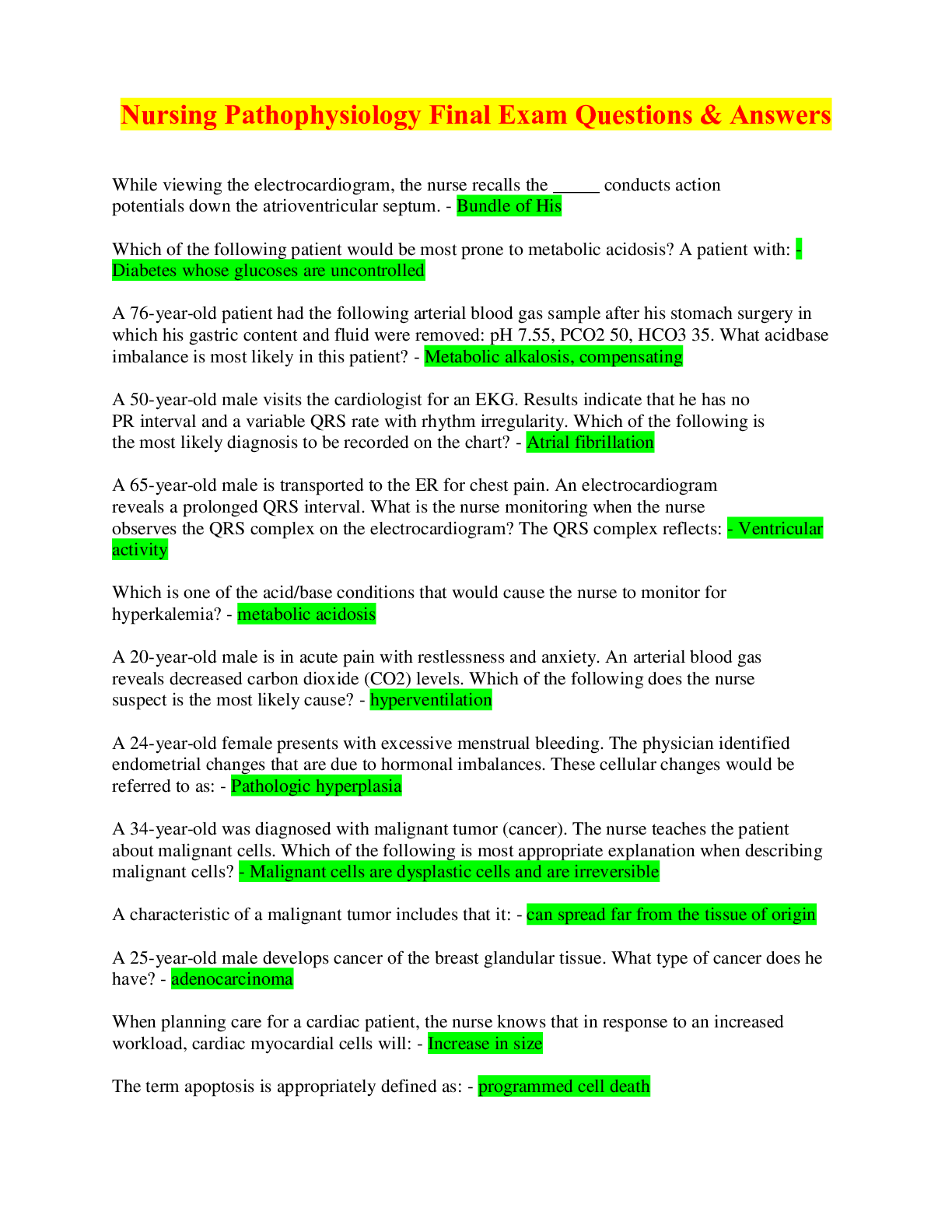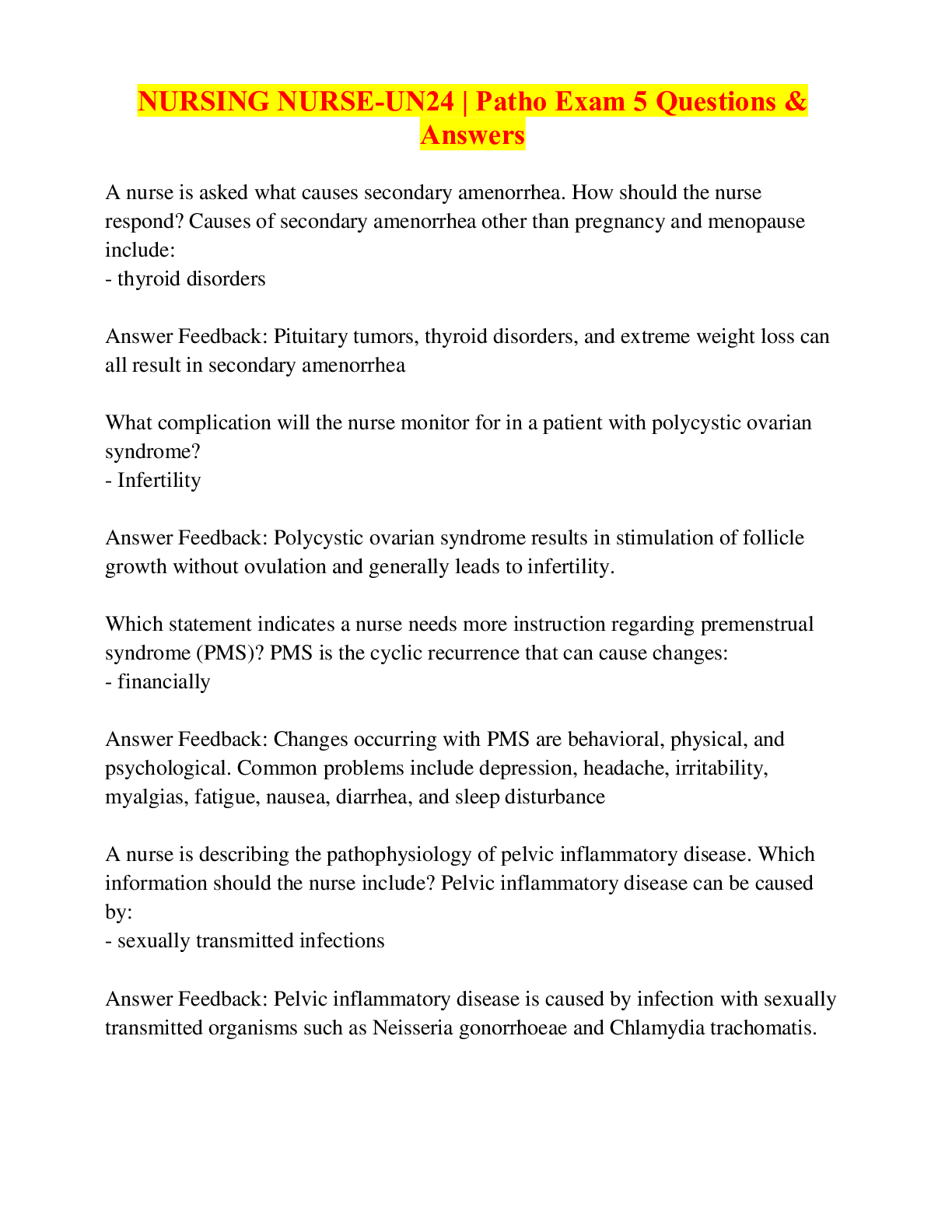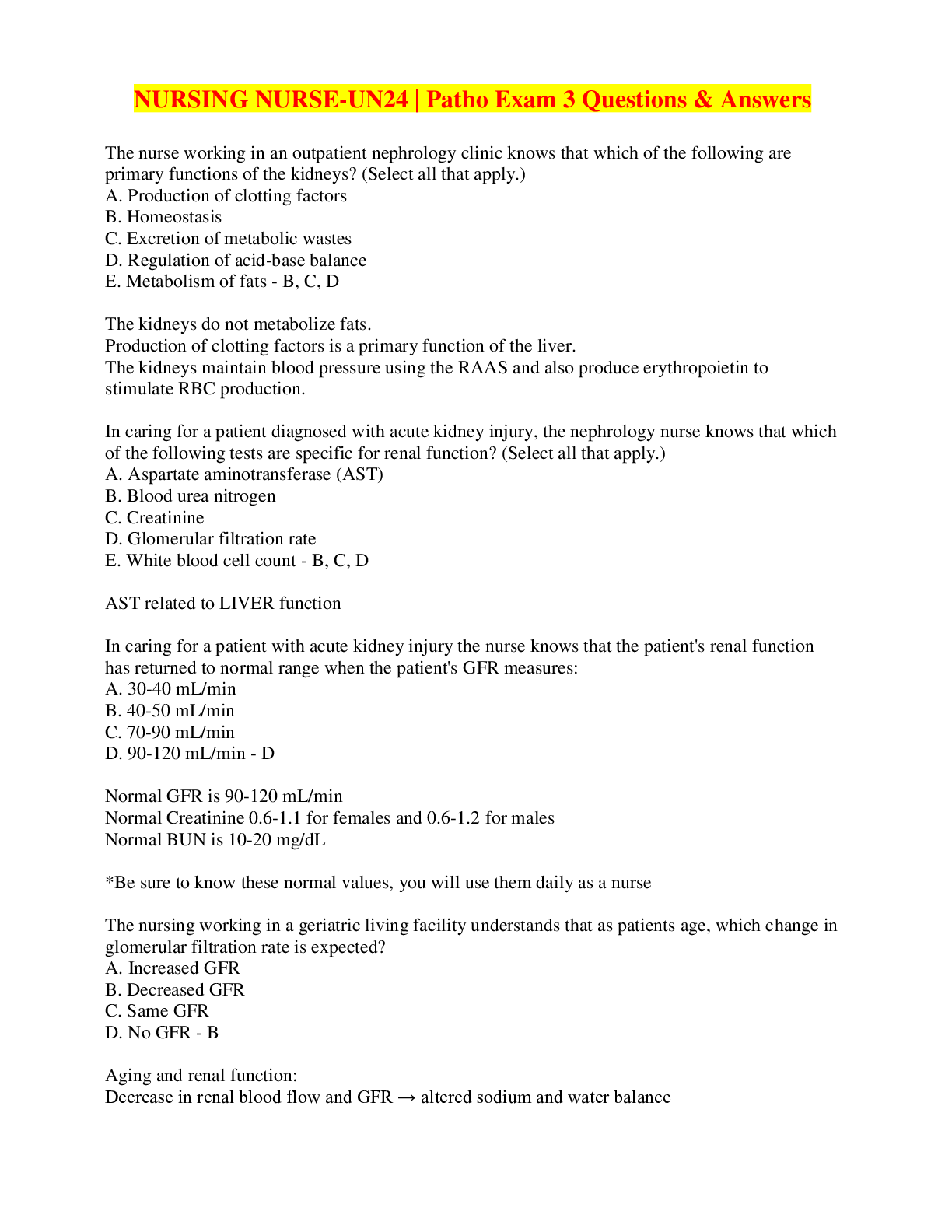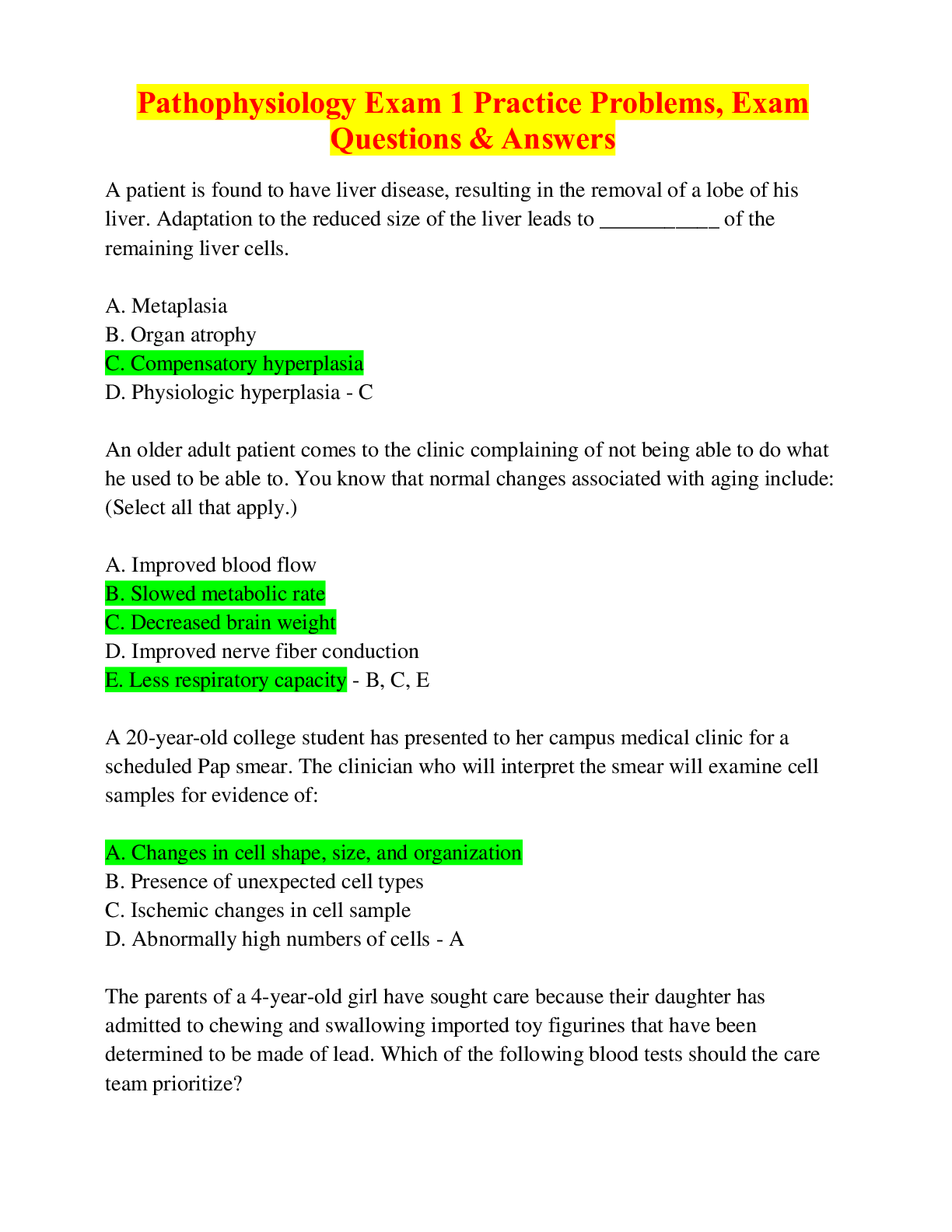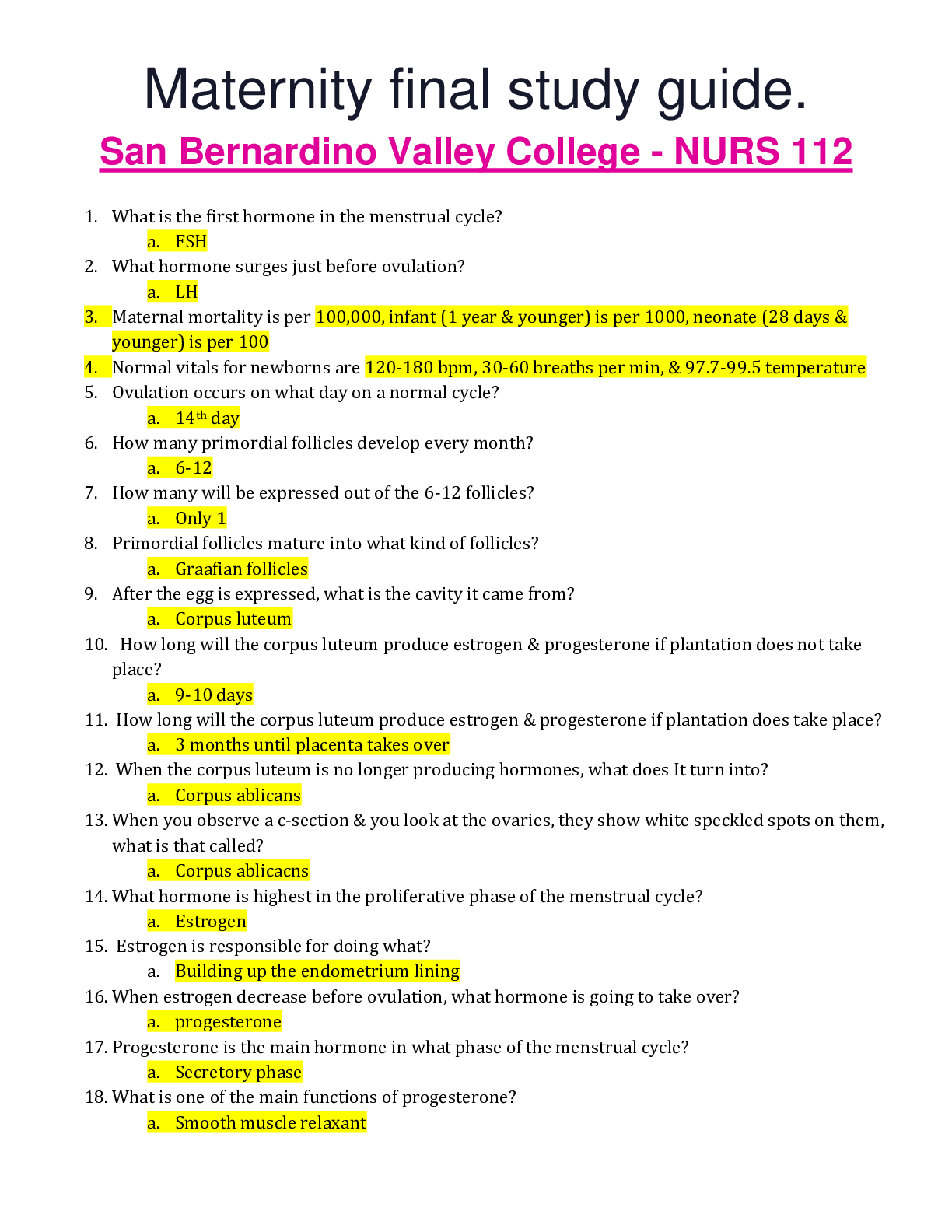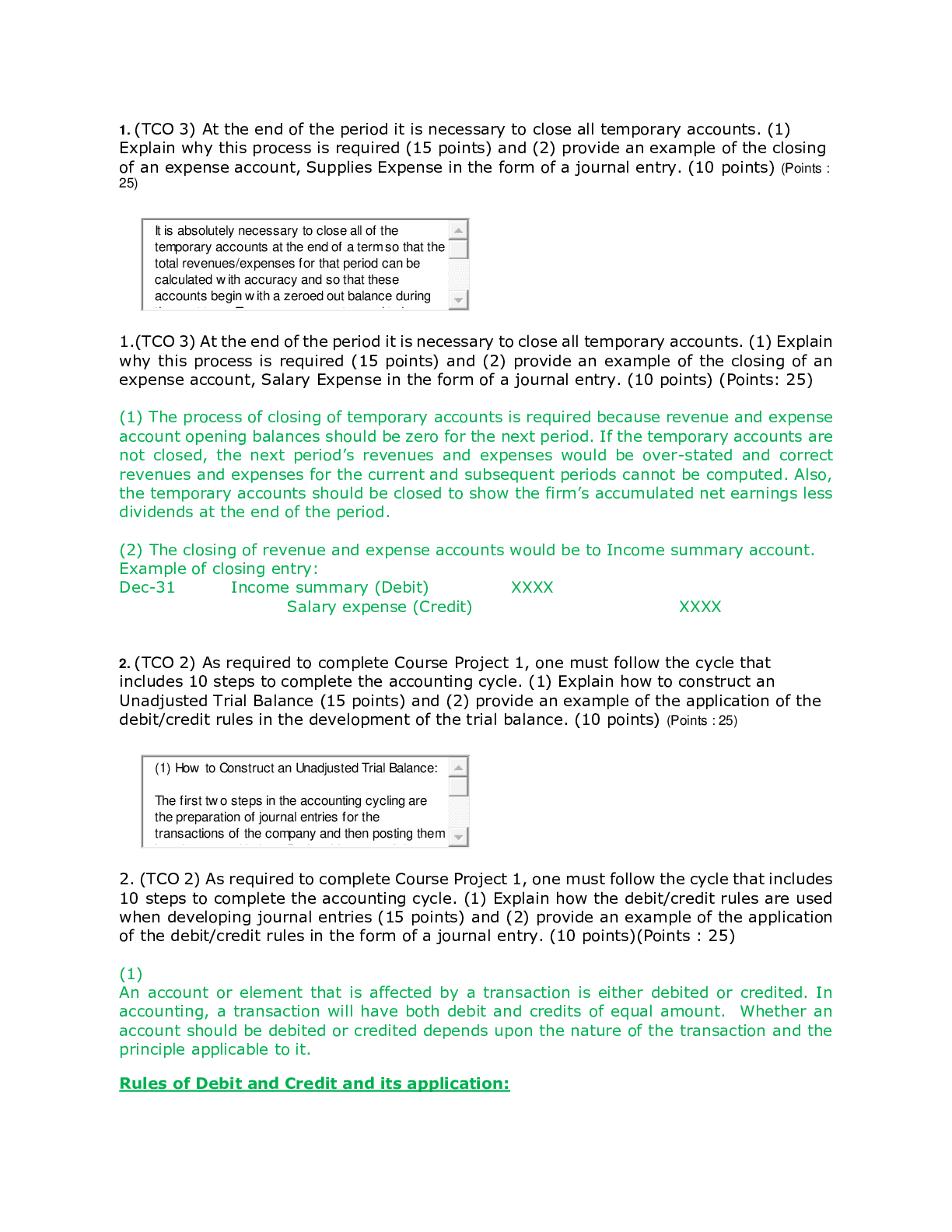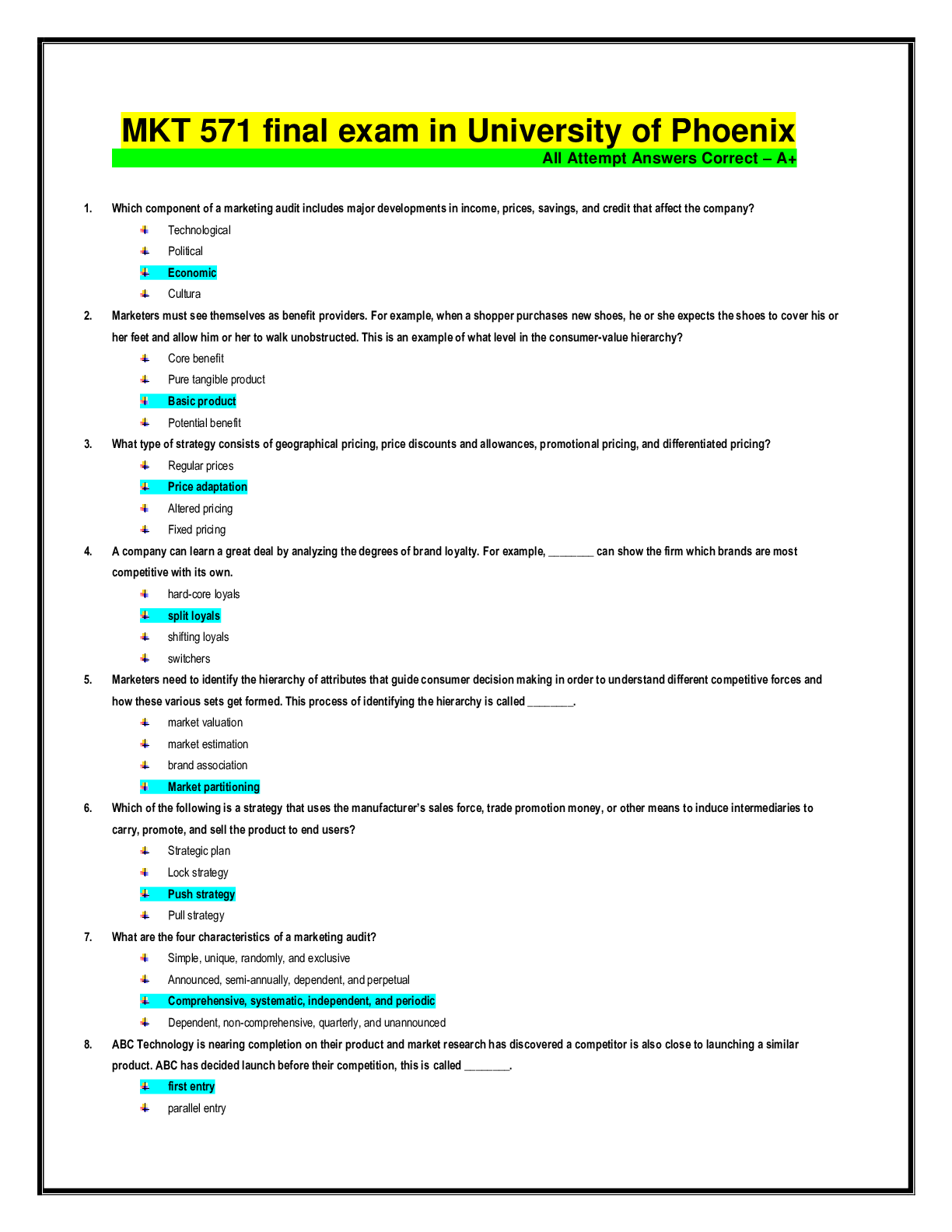*NURSING > EXAM > Nursing 101 Fundamentals of Nursing Practice Exam 1, Part 2, Exam Questions & Answers (Explained) (All)
Nursing 101 Fundamentals of Nursing Practice Exam 1, Part 2, Exam Questions & Answers (Explained)
Document Content and Description Below
Nursing 101 Fundamentals of Nursing Practice Exam 1, Part 2, Exam Questions & Answers (Explained)-During the change-of-shift report the night nurse states that a client mentioned having a bad experien... ce with surgery in the past. The nurse was called away and was unable to continue the conversation with the client. The nurse tells the day shift nurse about the comment and notes that the client appears anxious. When the day shift nurse visits the client to clarify the client's bad experience with surgery, the nurse is exhibiting which aspect of critical thinking? A. Integrity B. Discipline C. Confidence D. Perseverance - D. Discipline Discipline includes completing the task at hand, including assessments (which were not completed on the previous shift). Integrity includes recognizing when one's opinions conflict with those of others and finding a mutually satisfying solution. Confidence is demonstrated in one's presentation and belief in one's knowledge and abilities. Perseverance helps the critical thinker to find effective solutions to client care problems, especially when they have been previously unresolved. A client tells the nurse, "I'm not happy with the way the patient care technician did my bath. He just seemed to be in a hurry and did not wash my back like I asked." The nurse decides to go talk with the technician to learn his side of the story as well. This is an example of: A. Fairness B. Curiosity C. Risk taking D. Responsibility - A. Fairness Fairness involves analyzing all viewpoints to understand the situation completely before making a decision. Curiosity gives the critical thinker the motivation to continue to ask questions and learn more. Risk taking involves trying different ways to solve problems. The surgical unit has initiated the use of a pain rating scale to assess the severity of clients' pain during their postoperative recovery. The nurse assigned to a client can look at the pain flow sheet to see the client's pain scores over the last 24 hours. Use of the pain scale is an example of adherence to which intellectual standard? - D. Consistency Using the same pain scale for all clients and ratings promotes consistency—each nurse has the same measurement scale to compare assessments. Relevance refers to how applicable the assessment is. An assessment has depth when it deals with less obvious issues. Specificity refers to the ability of the assessment to provide information about the particular problem of interest. During the day the nurse spends time instructing a client in how to self-administer insulin. After discussing the technique and demonstrating an injection, the nurse asks the client to try it. After the client makes two attempts it is clear that the client does not understand how to prepare the correct dose. The nurse discusses the situation with the charge nurse and asks for suggestions. This is an example of: A. Reflection B. Risk taking C. Problem solving D. Client assessment - C. Problem Solving This is an example of problem solving because the nurse is taking a problem to a supervisor for help in finding a different approach. Reflection is the process of purposefully thinking back and recalling a situation to discover its purpose or meaning. Risk taking involves trying a different approach. Client assessment is the first step in the process of instruction. A nurse uses an institution's procedure manual to confirm how to insert a Foley catheter. The level of critical thinking the nurse is using is: A. Commitment B. Scientific method C. Basic critical thinking D. Complex critical thinking - C. Basic critical thinking At the basic level of critical thinking, a learner trusts the experts and follows a procedure step by step. Complex critical thinkers separate themselves from authorities and analyze and examine choices more independently. Commitment is the third level of critical thinking in which the person anticipates the need to make choices without assistance from others. The scientific method is a process of problem solving. A nurse refers to a client's postsurgical written plan of care, noting that the client has a drainage device collecting wound drainage. The surgeon is to be notified when drainage in the device exceeds 100 ml for the day. The nurse carefully notes the amount of drainage currently in the device. This is an example of: A. Planning B. Evaluation C. Assessment D. Intervention - C. Assessment Assessment is the process of observing and collecting data. Planning is the step in which the diagnosis is analyzed for problem resolution. Intervention consists of the steps actually taken after planning. Evaluation measures the effectiveness of the plan. The nurse asks a client how she feels about impending surgery for breast cancer. Before initiating the discussion the nurse reviewed information about loss and grief in addition to therapeutic communication principles. The critical thinking component involved in the nurse's review of the literature is: A) Experience B) Problem solving C) Knowledge application D) Clinical decision making - C. Knowledge application The nurse sought appropriate information to be able to communicate more knowledgeably with the client. Experience is acquired through clinical learning situations. Problem solving is a series of steps to resolve a problem. Clinical decision making is a process in which critical thinking steps are followed for problem resolution. Which of the following is the most accurate information to give a nurse during change-of-shift reporting? A) Client refuses to take medications. B) Client reports sharp pain in left anterior knee. C) Client encouraged to consume more fluids. D) Client expressed concern about pending surgery. - B. Client reports sharp pain in elft anterior knee The information in option 2 represents objective data that the nurse can use as part of baseline information. "Encouraged" and "more" are vague terms. "Concern" is also vague; relating the exact concern would be more accurate. Option 1 may be true, but accurate data would also report why the client refused medication. On entering a client's room during change-of-shift rounds, the nurse notices that the client and spouse have their backs turned to each other, and both have their arms folded across their chests. The best action for the nurse to take at this time is to: A) Introduce himself or herself and begin discharge teaching. B) Proceed with the tasks the nurse was intending to perform. C) Say nothing and leave quickly, closing the door behind. D) Ask the client and spouse if they need some time alone right now. - D. Ask the client and spouse if they need smoe time alone right now. The situation suggests that the nurse entered during a stressful time. Offering privacy would be appropriate. Because the situation indicates tension between the couple, this is not the time to initiate teaching. The nurse is assessing the urinary history of a middle-aged married woman. The nurse asks her if she gets up at night. She replies, "Yes." What other question should the nurse ask? A) "How many times do you get up at night?" B) "How long have you been getting up at night?" C) "Why do you get up at night?" D) "How easily do you go back to sleep after you get up?" - C. "Why do you get up at night?" Perhaps it is the client's husband who is getting up in the middle of the night because of a prostate problem, and this is why she is awakened. The nurse should not assume nocturia without further assessment questions. A client with diabetes mellitus who takes daily insulin injections is scheduled for surgery the next day. The client is to take nothing by mouth (NPO status) after midnight. The nurse questions whether insulin should be given the morning of surgery. This is an example of: A) Problem solving B) Previous experience C) Clinical practice guideline D) Scientifically based clinical judgment - D. Scientifially based clinical judgment The nurse is demonstrating awareness of the effect of insulin, which is to lower blood glucose level. Because the client will be NPO status for a long period of time, no calories will be consumed. Giving the usual injection of insulin could cause the client to experience hypoglycemia. [Show More]
Last updated: 11 months ago
Preview 5 out of 54 pages

Loading document previews ...
Buy this document to get the full access instantly
Instant Download Access after purchase
Buy NowInstant download
We Accept:

Reviews( 0 )
$14.50
Can't find what you want? Try our AI powered Search
Document information
Connected school, study & course
About the document
Uploaded On
Sep 04, 2024
Number of pages
54
Written in
Additional information
This document has been written for:
Uploaded
Sep 04, 2024
Downloads
0
Views
22

